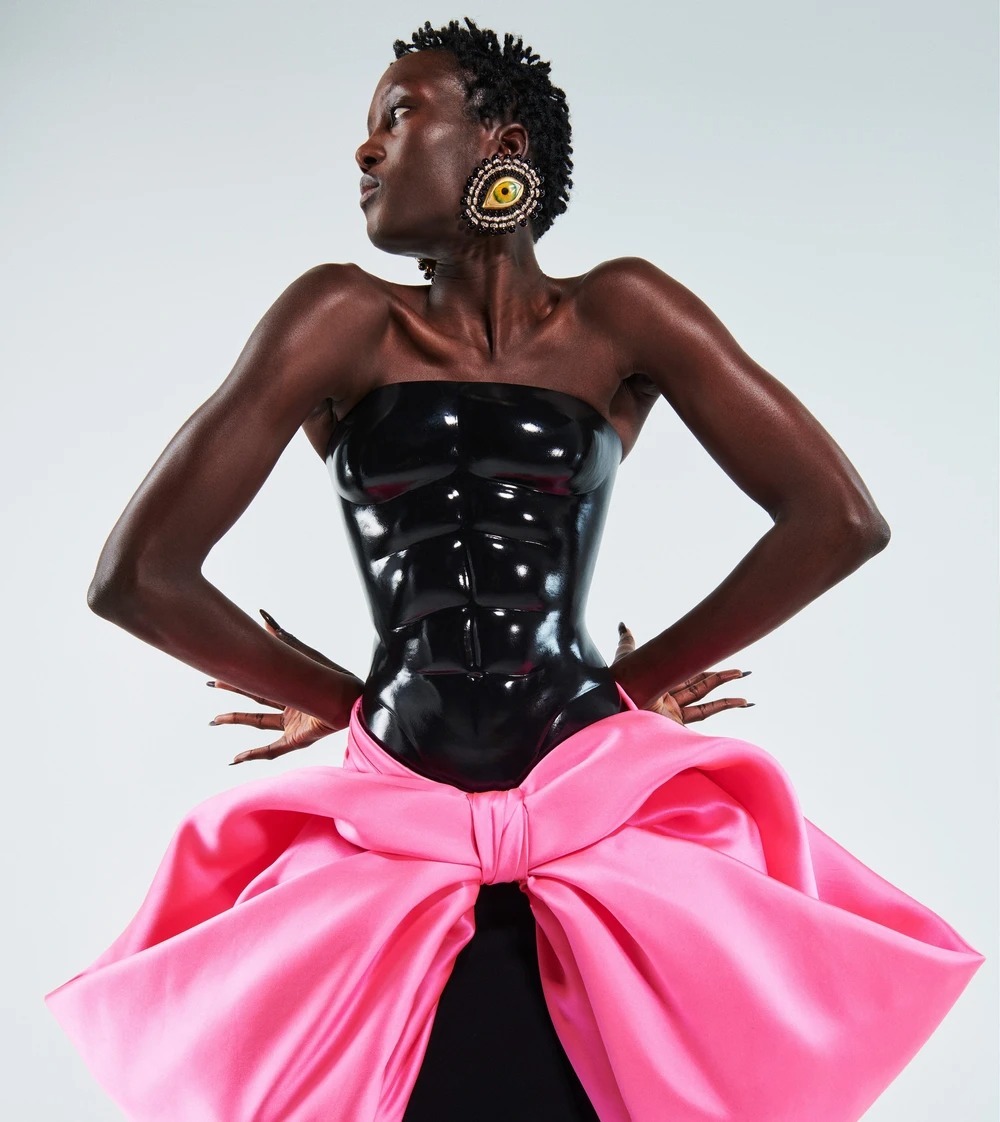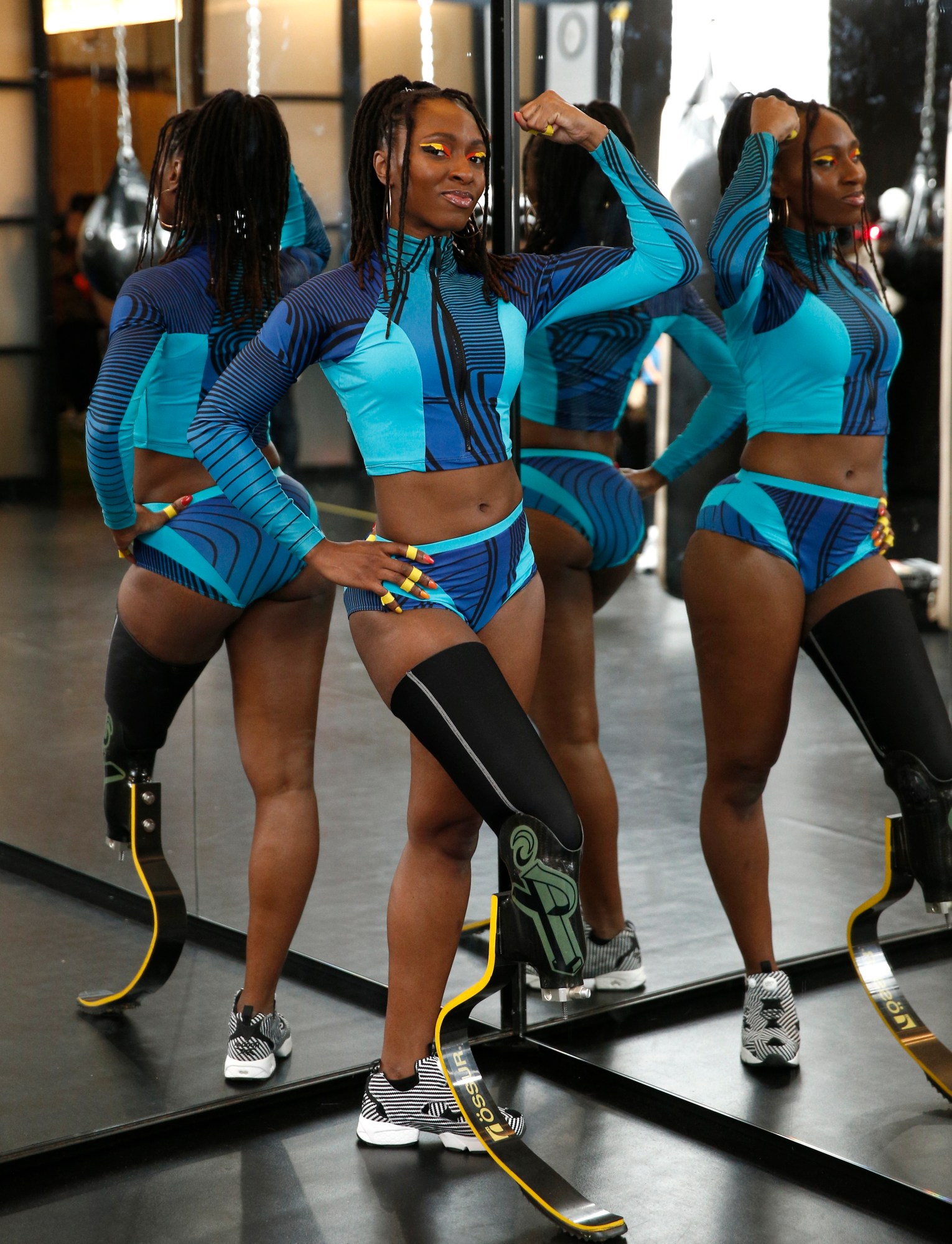The term ‘haute couture’ has, traditionally, connoted hyperfemininity; visions of dainty accessories, delicate embroideries and frou-frou gowns. That’s exactly why, this season, Schiaparelli’s SS21 haute couture presentation stood out — in particular, the muscular bodices at the collection’s heart. They brought a surprising hardness into the mix, such that the fashion brand dubbed the looks examples of “power couture” on Instagram.
The playful, surreal silhouette first went viral in December when Kim Kardashian wore a dark jade version, drawing comparisons to the Incredible Hulk. The moulded leather six-pack was, however, modelled on a pair of lifelike mannequins called Pascal and Pascaline, which Elsa Schiaparelli — the house’s founding couturier — kept in her salons. Whoever it belongs to, it’s the sort of physique that would require complete devotion to the gym; one that might prompt an eye roll at the sight of yet more unrealistic body standards on the runway.
Here, though, Daniel Roseberry, the house’s creative director, is presenting super-buff bods with a wink and a smile. And he’s just the latest in a long tradition of designers who’ve done the same. Jean Paul Gaultier, for example, famously played with muscle prints on bombers, knits and T-shirts throughout the 90s. When Robin Williams wore one of the French designer’s polka dot muscle shirts in 1995, the campy appeal of muscular motifs came to mainstream attention. The eccentric riffs on the sexualised male form that fill Walter van Beirendonck’s archive date back to a muscle print second skin top designed in 1997. And in 2014, Thom Browne took things 3D, sculpting cotton and tweed into bulging, sinewy silhouettes.

Of course, these muscular motifs are deliberately theatrical. They’re almost like props in a playful satire of the men who spend hours chiselling their physiques. Still, the fact that fashion’s engagement with jacked bods has typically been limited to menswear speaks to wider social preconceptions; namely, the false belief that defined muscles are synonymous with masculine strength. That’s why seeing them in Schiaparelli’s womenswear collection felt not just uncanny, but subversive. This was Daniel’s goal all along. “It’s about blurring the traditional lines of gender stereotypes while still celebrating femininity,” the designer explains. His muscular bodice, for example, is complemented by an exaggerated pink duchess satin bow, highlighting that flamboyant displays of femininity and depictions of women’s bodily strength are not mutually exclusive.
The garment is a direct counterpoint to those clothes that encourage women to shrink themselves — muscles, after all, proudly take up space. It’s a proposal that bucks “ideals of couture [that] were really formed during times when gender roles were defined by older, outdated ideas of what men and women should look like,” Daniel notes. “Other houses make couture that feels so delicate and quiet sometimes. Elsa [Schiaparelli] had a stronger hand, a boldness to her that I find so perfect for these times.”
Elsa approached fashion through a Surrealist lens, artfully tilting the familiar into the absurd. She was known for creating garments that teased the boundaries of taste and acceptability during the interwar years, working closely with Salvador Dalí on many of her most memorable designs. A particularly notable example is the 1938 Skeleton Dress, a svelte black silk evening gown with quilted ‘bones’ outlining those of the body beneath. In many respects, it prefigures Daniel Roseberry’s muscle bodice, placing it as the latest garment in the house’s long legacy of playful, subversive designs.
The fact that Schiaparelli’s SS21 haute couture collection was revealed just days after Joe Biden’s inauguration — for which Daniel designed a dress for Lady Gaga — was no coincidence. Indeed, celebrating Vice President Kamala Harris and all the other women in the new US administration was front of the Texan designer’s mind: “I hope this collection serves not just as a confirmation of a woman’s place in government, but also a confirmation that the divine feminine is as strong as the masculine,” he says. “I’ve been dreaming of our clients like they are superheroes, so the leather becomes muscles, the jewellery and body casting becomes like surreal armour.”
While fashion designers have occasionally drawn strength and inspiration from female wrestlers, bodybuilders and gym addicts, photographers have dived headlong into their world. Perhaps the most famous example is Robert Mapplethorpe’s collaboration with World Women’s Bodybuilding champion Lisa Lyon. A pioneer of female bodybuilding, Mapplethorpe’s black-and-white photographs of her taut muscles are a living testament to shifts in the perceptions of female strength and power during the 80s.
More recently, Martin Schoeller’s book Female Bodybuilders features full colour portraits revealing the protruding veins, glistening skin and bulky builds of women who have dedicated their lives to gaining muscle. The images were a source of inspiration for young designer Pierre-Louis Auvray, whose 2018 Central Saint Martins’ BA Womenswear collection focused on how fabrics reacted to their bulging physiques. “I liked the way the garment was stretched across the body,” he says. “They wore stretch fabrics so it was very sculptural. I thought that was really beautiful.”
To replicate this stretched look, Pierre-Louis handcrafted a foam muscle suit and covered it in thin latex layers. With its oversized muscles and glossy scarlet finish, the end result looks like it has stepped straight out of a superhero film. It received a mixed reaction. “Some people thought it was cool,” he smiles, “and others thought it was grotesque.” The designer put the suit on a female model because “it would have been a lot less striking if it was worn by a man. You expect a man to be muscular.”
Muscular motifs in womenswear may elicit shock (and, in Kim’s case, memes) but, more often than not, their impact doesn’t go much further than the realm of harmless cosplay. We can all relish in the campness of Kim K dressing up as a hench Grinch for Christmas, but grounds for claiming this as a victory for diverse body representation are tenuous at best.

There are, however, a new wave of designers that are directly challenging body norms and perceptions of feminine strength in their work. Schiaparelli’s bodice was moulded from mannequins, but what if it had been modelled from a real muscular body? Designer Sinead O’Dwyer offers something close to an answer with her shirred silk bodysuits and hand-poured silicone casts of the bodies of her muses. Visually striking, it’s their authenticity that gives these pieces their depth. They represent and celebrate the power, strength and validity of real bodies that have typically been ignored in fashion.
A similar vision of size inclusivity lies at the heart of New York-based bodywear label Chromat. Championing muscular feminine bodies is central to their mission, founder Becca McCharen-Tran says, stressing that their exclusion from the runway reflects the values of a patriarchal society. “Excluding muscular women in fashion sends a clear message to women: we want you to be small and not overpower men.”

“It’s patriarchy that idealises a man’s role as the most powerful person in the room,” she continues. “The patriarchy is threatened by strong women, and anyone who doesn’t conform to strict binary gender roles.” Such roles enforce the assumption that only men require clothes to fit a muscular physique. As such, sample sizing in womenswear is rarely calculated with athletic bodies in mind. “Sample sizing tends to be an excuse that other designers cite as a reason why they don’t feature a range of sizes in their runway shows,” Becca explains. “At Chromat, we know that the designer has the power to choose what size they prototype their collection in. Our goal is to encourage more designers to sample their collections in a range of sizes in order to celebrate all different size bodies on the runway, including muscular bodies.”
Whether your reaction to something like Daniel Roseberry’s muscle bodice is a laugh or a confused head tilt, seeing designers toy with our notions of ‘the dream body’ is both fun and much-needed. Just like Elsa Schiaparelli’s, these creative gestures make us stop and question why things are the way they are, whether they could be different, and what they could look like if they were. More often than not, muscular motifs are used for their inherently camp aesthetic value, but the conversations they spark allow us the opportunity to contemplate and reprogram our understanding of body and gender norms. On a lighter note, though, maybe they also offer a quick fix if your home gym routine hasn’t panned out as planned this lockdown. After all, why start working on your summer body when you can just buy one on a T-shirt?


